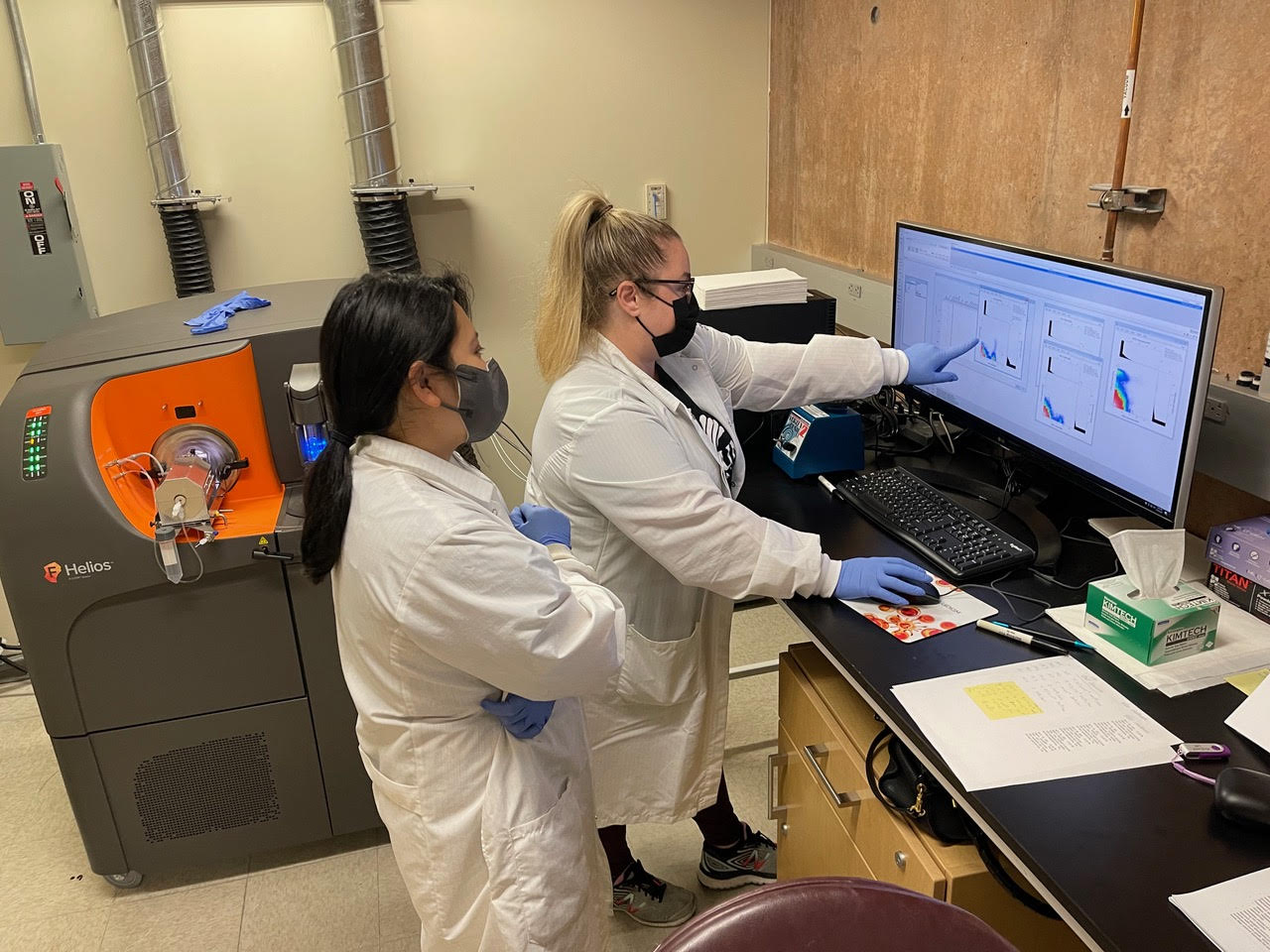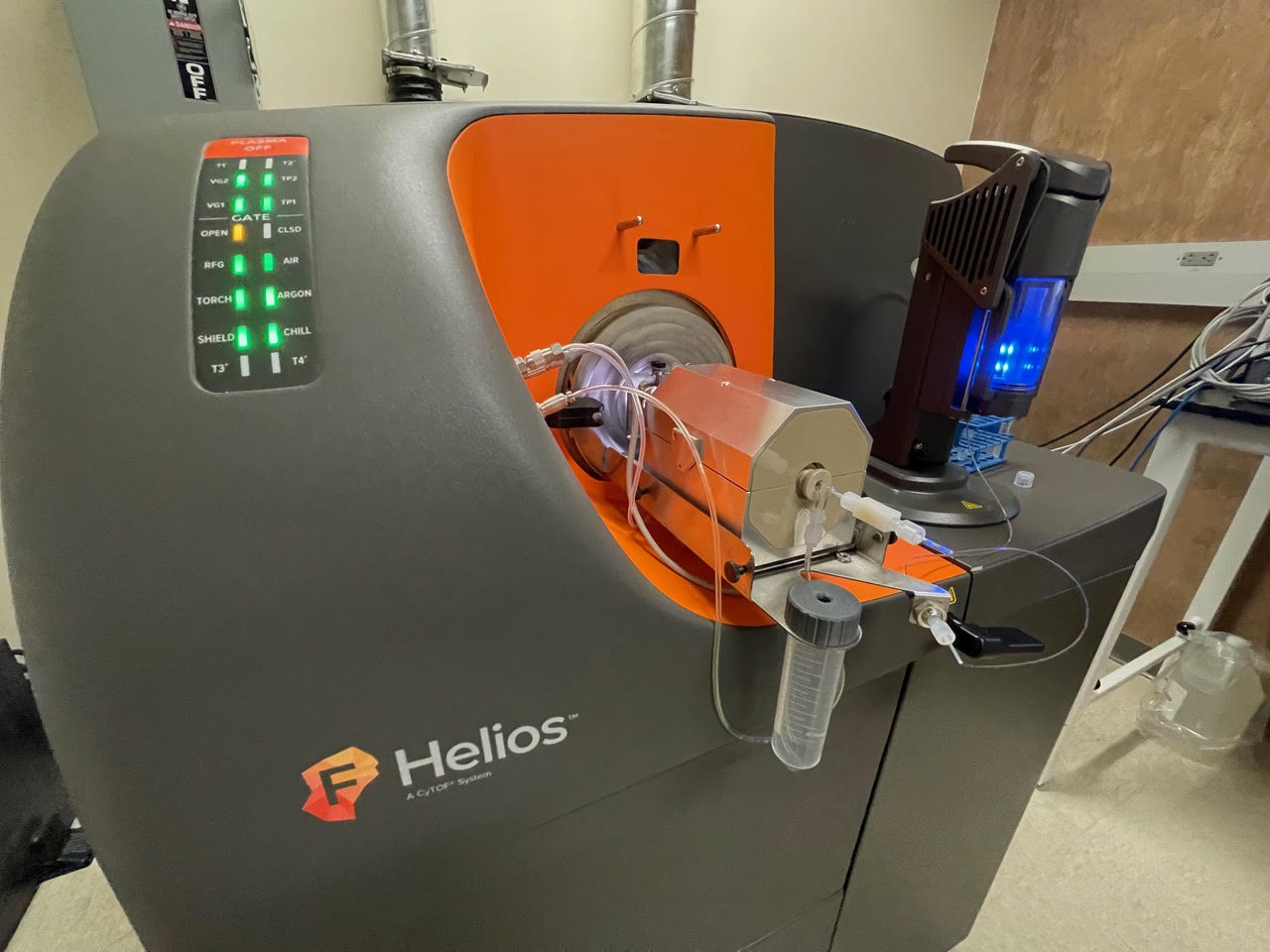First Experiment Run on Helios
First Experiment Run on Helios

On April 27, the Sue & Bill Gross Stem Cell Research Center (SCRC) flow cytometry core launched its newest instrument, the Helios mass cytometer by Fluidigm. Better known by its original name, CyTOF (Cytometer Time-Of-Flight), this device combines flow cytometry with mass spectrometry to allow single cell high parameter protein characterization of cellular identity and function on a level unprecedented at the UCI campus. The SCRC partnered with the UCI School of Medicine, Chao Family Cancer Center, School of Biological Sciences, and Office of Research to address an unmet research need of campus faculty. Acquisition of the Helios also leveraged a generous gift from Ann Cullen to the SCRC, highlighting the essential role of philanthropy in campus research and core facilities (https://stemcell.uci.edu/News/journals/cullen_story.php).
This is only the 3rd instrument of its kind on a UC campus, and the only one in Orange County. Installation of the Helios and establishment of the mass cytometry core took place over more than a year, requiring major facilities upgrades to vent the gases expelled by the instrument, and multiple visits by Fluidigm technical staff to install the instrument and train the SCRC staff, all during the COVID-19 pandemic. In preparation for the first experiments, the Core Manager Vanessa Scarfone and her research associate Pauline Nguyen performed multiple trial runs, optimization experiments, and met with countless researchers at UCI to plan strategy and design antibody panels. On April 28, the first experiment was run.
The First Experiment
Chris Halbrook, PhD, is a new faculty in the Department of Molecular Biology & Biochemistry and was recruited to UCI for his research on pancreatic cancer. Having experience with mass cytometry during his post-doc at the University of Michigan, he was eager to hit the ground running: “The goal of my research is to reprogram the tumor microenvironment to reduce immune suppression and enable immunotherapy. In order to fully understand the impact our interventions have on immune infiltrations; we want to be able to account for changes in both common and rare immune populations in this process. To accomplish this, we are using high-dimensional mass cytometry to characterize the baseline immune populations in primary and metastatic pancreatic tumors, and tracking how they change in response to therapeutic interventions.” The SCRC staff acquired, conjugated, validated, and titrated all the antibodies needed, his research associate Daniella Rastelli stained their first tumor samples and delivered them to the SCRC flow core to run. After analyzing their results, they identified unique differences in the immune response in tumors obtained from the pancreas and the liver. According to Dr. Halbrook: “I think this data illustrates the power of a high dimensional flow cytometry approach versus a targeted one.
Building Momentum
Since this first run, other researchers have been eager to begin their mass cytometry journey. Dr. Michael Hicks, a new assistant professor at the SCRC, has begun to validate and titrate a panel in collaboration with Dr. Armando Villalta, from the Department of Physiology & Biophysics. According to Dr. Hicks, “My lab is using the Helios to study cell fate decisions of developing skeletal muscle stem cells from iPSCs. This technology will improve the analysis of intracellular protein signaling, not possible by conventional flow cytometry. The Helios has provided an invaluable new direction for my lab to study inflammatory myopathies from precious human patient biopsies in collaboration with Drs. Armando Villalta and Tahseen Mozaffar at the UCI Medical Center.”
Before the Winter Break, a seed grant competition was announced for experiments using the Helios, and was awarded to 4 projects headed by Craig Walsh, PhD & Tom Lane, PhD, Matt Inlay, PhD, Maksim Plikus, PhD, and Armando Villalta, PhD & Michael Hicks, PhD. As more researchers learn about the power and potential of mass cytometry to transform their research capabilities, the SCRC flow cytometry core expects usage of the Helios to continue to rise. Vanessa Scarfone said, “As with most new technology, the activation energy to get these projects off the ground is high, but once researchers understand the process and realize it is accessible, the sky is the limit. My goal as core manager is to help investigators utilize this technology in a way that fits within their scope of work and their budget.”

The Hyperion Imaging Mass Cytometer
Anticipating the growing interest in this new technology at UCI, the SCRC submitted an S10 equipment grant to the National Institutes of Health (NIH) to expand the capabilities of mass cytometry to imaging. Spearheaded by Dr. Craig Walsh, the SCRC proposed to acquire the Hyperion, an add-on to the Helios that allows imaging of tissue sections far beyond what traditional fluorescent-based imaging allows. According to Dr. Walsh, “The true power of the Hyperion imaging mass cytometer (IMC) is its high resolution and high dimensionality relative to other imaging modalities. While other platforms may provide higher dimensionality, none provide the high resolution (1 square micron) and rapid turnaround that the Hyperion yields. The Hyperion will be transformational for the SCRC and investigators across the UCI campus and beyond." Additional support for the S10 grant was provided by the School of Medicine, the School of Biological Sciences the Cancer Center, and the Office of Research. On April 12, Dr. Walsh received word that the S10 was approved for funding. The Hyperion was purchased and arrived at the SCRC on July 8. The SCRC anticipates that the Hyperion will be installed and operational by the end of summer. It will be the first Hyperion at a UC campus.
Conclusion and Contact Information
Despite the difficulties of the past year, the establishment of the Helios mass cytometer is a bright spot and an example of what can be accomplished when the research community here at UCI bands together with a bold vision to adopt cutting-edge technology and expand the research capabilities of the UCI campus. All potential users, including those outside the SCRC and UCI, are welcome. Please contact Vanessa Scarfone, vscarfon@hs.uci.edu, to schedule an appointment to design your next mass cytometry experiment.
For more information, go to: https://stemcell.uci.edu/Resources/research_resources_landing.php